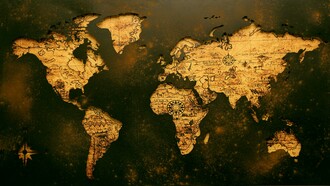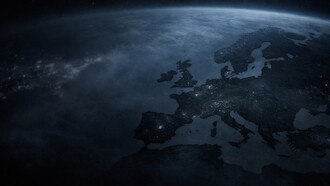Gaia is the Greek goddess of Earth and Nature, the alma mater of all creatures who live together in mystic unity, co-evolving and feeding each other.
Trees breathe in carbon dioxide and exhale oxygen. We breathe oxygen and exhale carbon dioxide. These systems survive together. Plants and animals have mutually balanced the earth's atmosphere since time immemorial. The biosphere is the totality of life on earth and is a geographical space occupied by living organisms, plants animals, bacteria, funghi. When combined with the atmosphere, hydrosphere, lithosphere and pedosphere this makes up the totality of life.
We live on a beautiful planet, full of secrets and surprises and we like to think we can control everything in its sphere. We change the course of water, reclaim land and even replant deserts, but can we see things in nature differently now? Everything depends on a healthy planet, but even so, man continues to destroy and abuse it. Our planet is endangered, ecosystems can no longer absorb and store carbon emissions and almost a million species are in danger of extinction because of deforestation, fires, exploitation of the sea. Healthy ecosystems clean our water, purify the air, maintain our soil, regulate the climate and provide us with food. They then sustain our economies by providing raw materials and resources. Nature and biodiversity are vitally important for our health and well-being and yet our fragile ecosystems and many species are now affected by the activities of humans and climate change.
A vast ecosystem like the Amazon rainforests may collapse in just a few decades and coral reefs in the Caribbean could do so in just a few years. Unfortunately, human activities have already depleted and drastically changed some of these ecosystems. People have made the oceans much more acid, exterminated thousands of species and depleted fish stocks, brought many species of animals and birds to the verge of extinction and cut down more than half of the rainforests of the world. Terrestrial land, forests, marine ecosystems, desert, grasslands, tundra, the Arctic and Antarctic are in absolute jeopardy. The more diverse species in the ecosystem, the more resilient the system is against changes or disasters. The homogeneous ecosystems or mono-cultures that we are creating are far more vulnerable.
As the human population has grown and increasingly dominated all available resources, it has made us directly responsible for the future of the ecosystem on which we and all other forms of life depend. The earth's atmosphere is 78 percent nitrogen, 21 percent oxygen and 1 percent other gases, such as carbon dioxide, water vapour and argon. Much like a greenhouse, this blanket of gases absorbs and retains heat. On average, the earth's surface temperature is about 57 degrees Fahrenheit. Without our atmosphere, it would be zero degrees. Yet, in the last two centuries, humans have added enough greenhouse gases to the atmosphere to make the Earth's average temperature rise by 1.8 degrees Fahrenheit. This extra heat has already altered the Earth's weather patterns in many ways. The atmosphere nourishes life on Earth and protects it. It is thick enough that its gases, such as ozone, block the DNA damaging ultraviolet light from reaching the surface. Earth's atmosphere lies within just 10 miles of the planet's surface.
Free energy as the answer to our problems offered by Tesla in 1927 was rejected (energy based on magnetism, giving a return of 90 percent) by the patent office and the inventors harassed so that we still serve the petro-dollar. There continues to be massive oil extraction which in turn continues to have a devastating impact on greenhouse gas emissions. The average duration in the atmosphere of the carbon dioxide deriving from the consumption of fossil fuels is one hundred years. The levels of carbon dioxide in 2019 reached the highest point in the entire human history. The Earth’s climate is changing because man's increasing use of combustion fossils is changing the chemical composition of the atmosphere. All the energy produced comes from combustion of wood, coal, oil, gas and the process of rapid industrialisation of the last century has continued to produce an increase in the release of carbon dioxide into the atmosphere.
Climate change is the most serious threat facing our planet today. Carbon emissions must be reduced to the levels agreed on Climate Change Agreement signed by 190 governments at the UN Conference, COP 21 in Paris, to prevent catastrophic harm. Surely, this is particularly important as the global energy demand is expected to increase by 60 percent over the next decades. In order to avoid further catastrophic harm 85 percent of the world's energy supply should be shifted to non-fossil fuel sources, and we will also need to invest in smart renewable energy development, solar panels and turbines.
Man continues to accumulate enormous amounts of toxic garbage and extremely poisonous chemicals to all food chains, depleting vital freshwater resources, with many lakes and rivers and polluting huge areas of land. Everybody produces different kinds of waste in different quantities every day. Most of this waste ends up in landfills harming the environment. Proper management of waste is one of the most efficient ways to protect the environment, the health of the planet and thereby creating a more sustainable future. Every day we are advanced in terms of utilising technology for efficient waste management through recycling and composting. A great deal of waste that people produce includes non-biodegradable items such as plastic and tin, cardboard and paper, which can be recycled and reused instead of ending up in landfills and our seas. Plastic waste is rising so much every day that it now affects 90 percent of marine life and animals.
More than 80 percent of our wastewater is pumped into rivers, lakes and oceans, as well as 300-400 million tons of untreated heavy metals, toxic waste and other industrial discharges. All the while emissions, carbon dioxide and global heating continue to rise.
Agriculture and fishing are the primary causes of the deterioration of our ecosystems. Food production has increased dramatically, which has helped feed our growing global population and generated jobs and economic growth. But this has come at an extraordinarily high cost. The meat industry has had a particularly heavy impact on global greenhouse gas emissions. Human activity has impacted both the abundance and diversity of animals and plants. Even the very insects which are crucial to plant pollination are becoming threatened with extinction. Agricultural expansion could devastate habitats, release more carbon into the atmosphere, dry up rivers leading to deforestation and uses 70 percent of freshwater supply. Agriculture has to stop the misuse of fertiliser practices that pollute our waters. For example, in Brazil half of all-natural habitats have already been converted to crops and pasture. It is essential to co-operate with farmers on sustainable practices in order to identify how they can produce more whilst at the same time restoring the forests and savanna's wildlife.
We must eliminate overfishing, which is devastating to fish species and is endangering the ocean ecosystems by disrupting the balance of all sea life. Without serious changes, 85 percent of the world's fish stocks will be in peril in our lifetime. By refining fishing methods the oceans can be more abundant and therefore far healthier in the future. Indonesia, for example, uses artificial intelligence to identify fish species and track their numbers, so fishermen can avoid catching too many of the wrong kind. Ocean stability is a vital regulator of global climate and the productivity of marine ecosystems, which feed a substantial portion of the world's population. The temperature of the oceans as well as the salinity and pressure controls the density of seawater. This means that the ocean surface becomes denser and increases with depth. The sunlight that warms the ocean is absorbed in the surface, whereas the deep ocean is full of cold water.
Plankton carried by sea currents is at risk. In the plankton, there is everything, shrimps, fish in larval state, snails, sea urchin and crab larval, jellyfish. But above all, there are microorganisms capable of carrying out photosynthesis. Two-thirds of the world's oxygen production is due to phytoplankton - why plankton is so incredibly important and a fundamental element for the life in the oceans. Without plankton in the seas there would be no life. The acidification of the surface waters of the oceans caused by the excessive presence of carbon dioxide in the atmosphere, in turn, causes dissolution of the organisms with calcareous skeletons, which are abundant in plankton. Their decline will block the functioning of food chains.
Corals and mangroves will not survive the heating of the ocean. Globally, ocean acidification is on the rise, while seagrass ecosystems are in decline. Seagrass naturally absorbs carbon and is valuable for climate mitigation, erosion control and wildlife habitat. Seagrasses are marine forests. Sea turtles, bat rays, leopard sharks, harbour seals, seahorses, colourful sea slugs, fish are just some of the creatures that visit seagrass ecosystems for the food and habitat they provide. The Dungeness crab and spiny lobster and many birds visit seagrass meadows, specifically to dine on what is beneath their swaying blades of grass. Mangrove habitats are crucial for many different creatures and are a vitally important protection against climate change, with one acre of mangrove forest absorbing nearly the same amount of carbon dioxide as an acre of Amazon rainforest. Protecting these ecosystems is essential in protecting many species which include the sargassum frogfish, green sea turtle, amphibious fish such as mudskippers, jellyfish and various reptiles.
The National Oceanic and Atmospheric Administration explain how increases in temperatures in the atmosphere and in the ocean are also contributing to the continued loss of ice-mass in Greenland and Antarctica. This in turn is leading to the rise of extreme events such as heatwaves, fires and violent rainfalls. Frozen worlds, which are extraordinary places, are also rapidly changing. Every day the North Pole is reducing by nearly 150 meters. And our wonderful Earth is certain to continue to experience disasters caused by climate change. The inner earth creates new land every hour and the world's glaciers move mountains. These rising temperatures also lead to a phenomenon known as, ‘permafrost’, which has a very high environmental impact on the sets of soil layers that remain frozen for long periods, even centuries. Because of the melting of this permafrost the carbon and methane present in the frozen subsoil could be released into the atmosphere, thus further amplifying the effect of greenhouse gases and accelerating it, which in turn causes a structural weakness of the soil.
All these changes in the various habitats of the Earth produce effects on the plants and animals that live in them. In general, it is the polar species of the tundra and the alpine creatures that appear to be most affected by temperature increases. The decline of polar bear populations following the reduction of the pack ice is a stark symbol of change. Also, reindeer are suffering from the climatic change of the Arctic zones, which, because of the milder temperatures are no longer suitable for their well-being and ability to reproduce. Many other Arctic species such as seals, whales, narwals and walruses also depend on the ice. Seals, the main prey of polar bears, are particularly vulnerable to the reduction of floating ices because they give birth and feed their cubs on it, as well as using it as a platform to rest. The predators unfortunately cannot wait because they must consume as many seals as possible before winter arrives. This food supply will allow the bears to set aside a reserve of fat enough to survive a long Arctic winter and in particular for females to complete their pregnancy.
We are sending out an urgent S.O.S. appeal for the Arctic continent.
The impact on the animal world and the effects on the plant world are changing the geography of nature and we are now totally out of balance with it. The most affected regions are Amazonia, Alaska, Antarctic, Arctic, Siberia, Sahel (a region in Africa between the Sahara to the north and the Sudan savanna to the south, which has a semi-arid climate), West Africa, Indonesia, Central-Eastern Asia, also the Mediterranean Basin, where the average temperature has increased and heatwaves have greater intensity. At the end of 2019, an area the size of Great Britain burnt in Australia and a land and sea heatwave resulted in record temperatures in Australia, 52 degrees centigrade.
The population of wild animals has reduced by 60 percent in the last decades and without biodiversity the world as we know it cannot exist. Living species are disappearing at a rate that is one hundred times higher than normal, according to the latest alarming report by the UN body on biodiversity. In Australia, more than 50 animal and 60 plant species have been lost forever. This is the highest rate of mammalian extinction in the world over the last two hundred years. One of the main threats to Australia's and the Amazon's biodiversity is habitat loss. However, in Eastern Australia land clearing is still going on. Also, the effects related to climate change are manifested in the reproductive capacity of many animals. The impact of human activities has put all animal groups under stress, but among vertebrates, none are more threatened than frogs. The main threat to their survival is habitat destruction. Amphibians are important to control mechanisms of ecosystems because they devour many harmful insects. And the availability of frogs and fish in wetlands is linked to the survival of herons, sacred ibis and the little egret. The deaths of bees and butterflies are diminishing the availability of pollinating insects, with consequent difficulties for the pollination of fruit trees and many vegetables. Climate changes have begun to push the fearsome tsè-tsè fly and exotic mosquitoes towards African cities, carrying the risk of serious infectious diseases to humans.
Our planet and its natural beauty are simply magnificent. It is filled with awe-inspiring natural wonders. Nature's ecosystems are well-balanced and they all contribute to maintaining life on Earth. Immersing ourselves in nature can have a profound impact on our entire well-being. Positive signals have come from the European Commission with the launch of the European New Green Deal, in adherence to the UN Agenda 2030, the strategy for sustainable development. Various European states are considering investing 117 billion euros in new fossil gas infrastructures. The industrial sector is responsible for 29.6 percent of total greenhouse gas emissions and the old industrial countries will distribute 100 billion per year to spread green technologies all over the world and to decarbonise the economy.
We need to urgently and rapidly reduce global emissions using new innovative technologies to stop overconsumption, stop heavy industry, stop the overuse of combustion, stop plastic, stop pollution.
The risk is global and the action should be global. To continue to enjoy the extraordinary spectacular beauty of nature, humanity has to prepare for changes. All of us have to do our part to protect the sustainability of life as we know it on planet Earth.
Be Earth-friendly, save the planet, love nature and find beauty everywhere.















